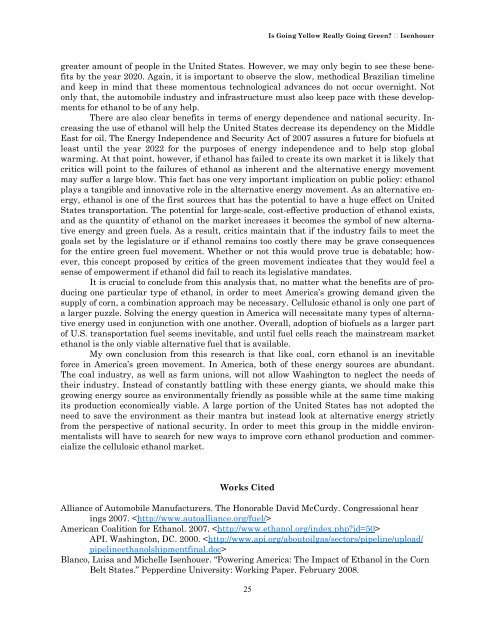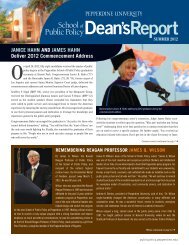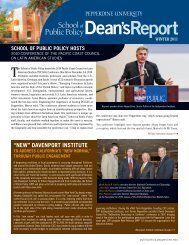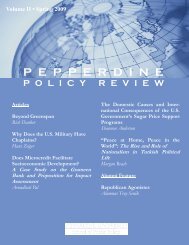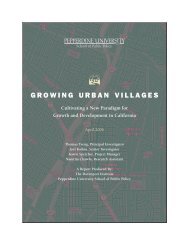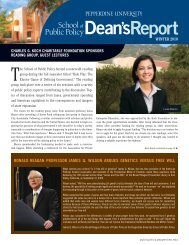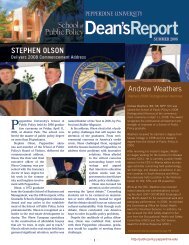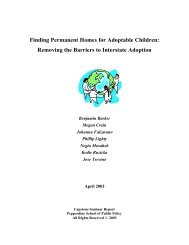Pepperdine University School of Public Policy
Pepperdine University School of Public Policy
Pepperdine University School of Public Policy
Create successful ePaper yourself
Turn your PDF publications into a flip-book with our unique Google optimized e-Paper software.
Is Going Yellow Really Going Green? Isenhouer<br />
greater amount <strong>of</strong> people in the United States. However, we may only begin to see these benefits<br />
by the year 2020. Again, it is important to observe the slow, methodical Brazilian timeline<br />
and keep in mind that these momentous technological advances do not occur overnight. Not<br />
only that, the automobile industry and infrastructure must also keep pace with these developments<br />
for ethanol to be <strong>of</strong> any help.<br />
There are also clear benefits in terms <strong>of</strong> energy dependence and national security. Increasing<br />
the use <strong>of</strong> ethanol will help the United States decrease its dependency on the Middle<br />
East for oil. The Energy Independence and Security Act <strong>of</strong> 2007 assures a future for bi<strong>of</strong>uels at<br />
least until the year 2022 for the purposes <strong>of</strong> energy independence and to help stop global<br />
warming. At that point, however, if ethanol has failed to create its own market it is likely that<br />
critics will point to the failures <strong>of</strong> ethanol as inherent and the alternative energy movement<br />
may suffer a large blow. This fact has one very important implication on public policy: ethanol<br />
plays a tangible and innovative role in the alternative energy movement. As an alternative energy,<br />
ethanol is one <strong>of</strong> the first sources that has the potential to have a huge effect on United<br />
States transportation. The potential for large-scale, cost-effective production <strong>of</strong> ethanol exists,<br />
and as the quantity <strong>of</strong> ethanol on the market increases it becomes the symbol <strong>of</strong> new alternative<br />
energy and green fuels. As a result, critics maintain that if the industry fails to meet the<br />
goals set by the legislature or if ethanol remains too costly there may be grave consequences<br />
for the entire green fuel movement. Whether or not this would prove true is debatable; however,<br />
this concept proposed by critics <strong>of</strong> the green movement indicates that they would feel a<br />
sense <strong>of</strong> empowerment if ethanol did fail to reach its legislative mandates.<br />
It is crucial to conclude from this analysis that, no matter what the benefits are <strong>of</strong> producing<br />
one particular type <strong>of</strong> ethanol, in order to meet America’s growing demand given the<br />
supply <strong>of</strong> corn, a combination approach may be necessary. Cellulosic ethanol is only one part <strong>of</strong><br />
a larger puzzle. Solving the energy question in America will necessitate many types <strong>of</strong> alternative<br />
energy used in conjunction with one another. Overall, adoption <strong>of</strong> bi<strong>of</strong>uels as a larger part<br />
<strong>of</strong> U.S. transportation fuel seems inevitable, and until fuel cells reach the mainstream market<br />
ethanol is the only viable alternative fuel that is available.<br />
My own conclusion from this research is that like coal, corn ethanol is an inevitable<br />
force in America’s green movement. In America, both <strong>of</strong> these energy sources are abundant.<br />
The coal industry, as well as farm unions, will not allow Washington to neglect the needs <strong>of</strong><br />
their industry. Instead <strong>of</strong> constantly battling with these energy giants, we should make this<br />
growing energy source as environmentally friendly as possible while at the same time making<br />
its production economically viable. A large portion <strong>of</strong> the United States has not adopted the<br />
need to save the environment as their mantra but instead look at alternative energy strictly<br />
from the perspective <strong>of</strong> national security. In order to meet this group in the middle environmentalists<br />
will have to search for new ways to improve corn ethanol production and commercialize<br />
the cellulosic ethanol market.<br />
Works Cited<br />
Alliance <strong>of</strong> Automobile Manufacturers. The Honorable David McCurdy. Congressional hear<br />
ings 2007. <br />
American Coalition for Ethanol. 2007. <br />
API. Washington, DC. 2000. <br />
Blanco, Luisa and Michelle Isenhouer. “Powering America: The Impact <strong>of</strong> Ethanol in the Corn<br />
Belt States.” <strong>Pepperdine</strong> <strong>University</strong>: Working Paper. February 2008.<br />
25


